Moshi Moshi Nippon 2014 was an all-day festival in Tokyo which took place on a recent Sunday and was organized by Asobi System, the agency behind Kyary Pamyu Pamyu. Asobi System manages many similar pop-idol groups, as well as Harajuku fashion models and the like, and their manifesto is to spread eye-popping Harajuku culture to the world.
The festival featured dozens of pop artists and DJs over three stages, plus a fashion catwalk. Kyary Pamyu Pamyu—SPOILER ALERT—was the headliner of course.
Videos by VICE
Asobi System conceived Moshi Moshi Nippon as a way to spread its name overseas, and so while tickets cost around $35 for Japanese fans, foreigners were given free entry. But the really weird thing was the segregated viewing areas. Japanese fans had to stand at the back, or even way off in the second- and third-floor balconies, while foreigners got their own spot right at the front.
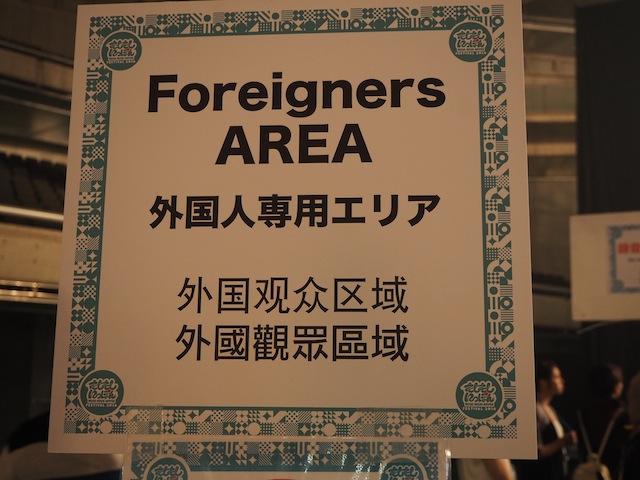
Racist? Of course not, but definitely a bit misguided. And maybe a little cynical too, since the front of the crowd obviously got the most coverage from the crowd-facing video cameras. Japanese music companies love to show Japanese fans how popular their artists are with foreigners because it makes them seem cooler, and here was a chance to capture evidence of it on camera.
Not that I’m saying Asobi System doesn’t care about overseas success as well. You can tell how serious it is by the carefully written English blurb on its website:
“THAN MAKING THE BOOM, TO CREATE A CULTURE.
MORE SHOULD BE SEND TO THE ERA OF NOW ‘PLAY’”
Anyway, I asked some of the foreigners in the audience how they felt about the festival and I’ll tell you what they said later.
The event drew 15,000 people, around 3,000 of whom were not from Japan (according to that ever-reliable font of statistics, Kyary Pamyu Pamyu). In addition to all the stuff on stage there were stalls selling clothes worn by models on shoots or giving free hairstyling, makeup, nail art, face-painting and more—you could have turned up naked because everything a fashionista could want was there. The media area was a scrum of music journalists, fashion bloggers, and morning variety TV shows.
It drew a very mixed crowd of pop-idol fans (usually sweaty older men), beauty queens, and dreamboat hunks with wild styles. Plus young kids in school uniform: sometimes it was hard to tell whether they were wearing their real school clothes or just making a fashion statement.

Pretty sure this guy (Nishimura Hiyokochang) doesn’t wear that getup every day though.

Speaking of school children, the first act on the main stage was Tempura Kidz, a group of ultra-adorable pre-adolescent dancers in crazy clothes who also dance for Kyary Pamyu Pamyu. Despite their age they’re incredibly tight dancers.
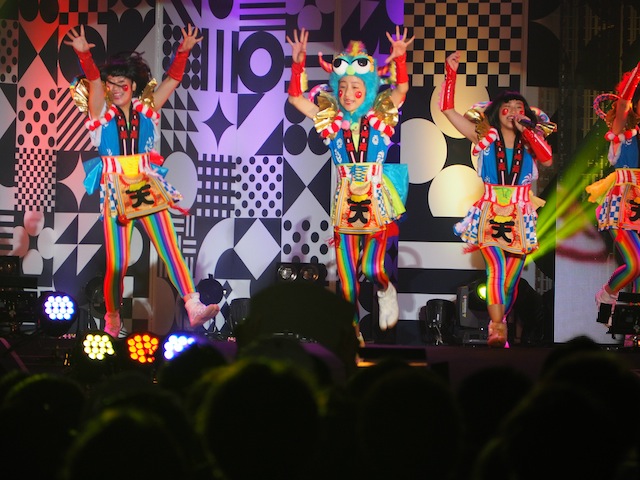
Dempagumi.inc are a little older, but their live set was like a riot at a children’s party. Their music is an awesome combination of idol pop and rock, with songs that chop and change like a rhapsody and explode with fun.

The girls from Dempagumi.inc also took part in a fashion show. Here’s Ayane “Pinky” Fujisaki pulling the coolest pose ever to grace a catwalk.

The fashion shows were grouped by collection or magazine. Some of them were relatively demure, while others burst with the vibrant colors and bold styles you’d expect of Harajuku. These two were from a collection by Zipper magazine.
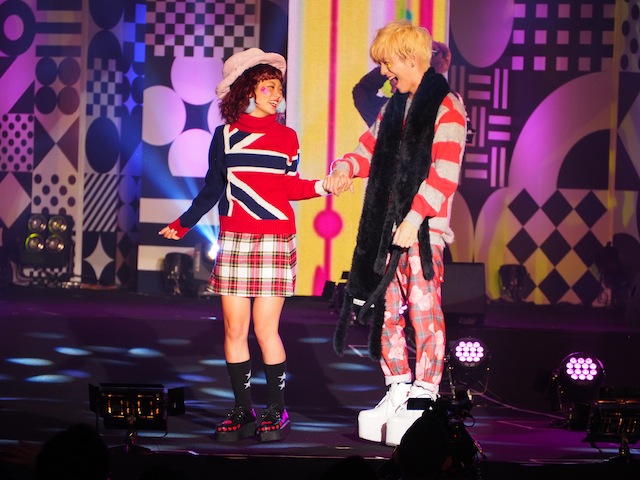

The fans had their own fashion thing going on, too. Most of the foreigners I spoke to were residents of Japan, so they were well up on the local styles. The ladies in particular made an effort to replicate the Harajuku look.
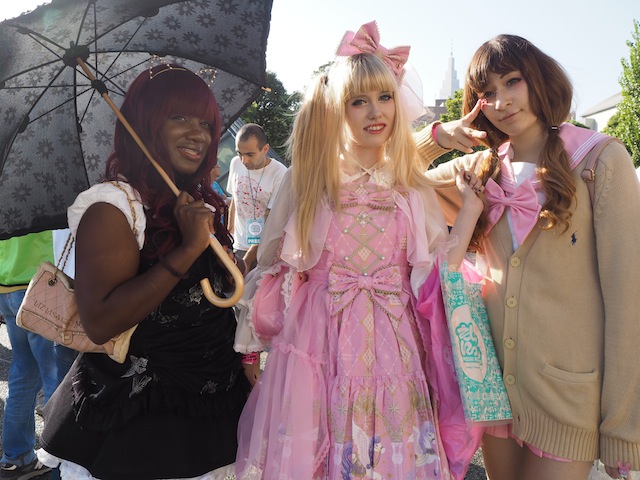
Which is a pretty good approximation of the real thing…

Most of the peacocking took place in the open-air plaza outside the entrance, where DJs played electro-pop beats from a small stage. This area was also used by the less well-known idol groups on the bill to work the crowds and service their fans. Groups like Predia did handshaking events for fans who’d bought something from their merch stand.

This group, Luce Twinkle Wink, were autographing cute little inflatable goldfish that customers plucked from a tank, in a play on the traditional Japanese “matsuri” (festival) game of “kingyo-sukui.”
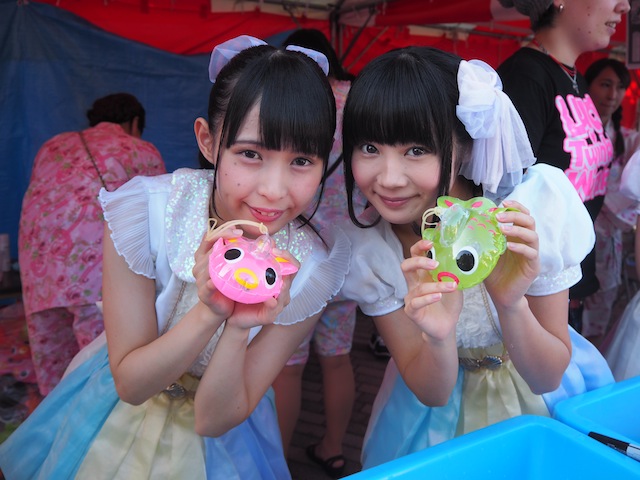
I went to see Luce Twinkle Wink perform later, and they were truly terrible. But here’s a happy customer.

In fact, everything I saw on the middle-sized stage was awful. These were the real C-grade pop-idol groups who are unknown in Japan and will probably stay that way. After going to such lengths to invite a foreign audience, it seemed a bit odd to book a lineup of acts so unlikely to appeal to them.
This group is called Camouflage, presumably because of the subtlety of their outfits that would blend with any environment.
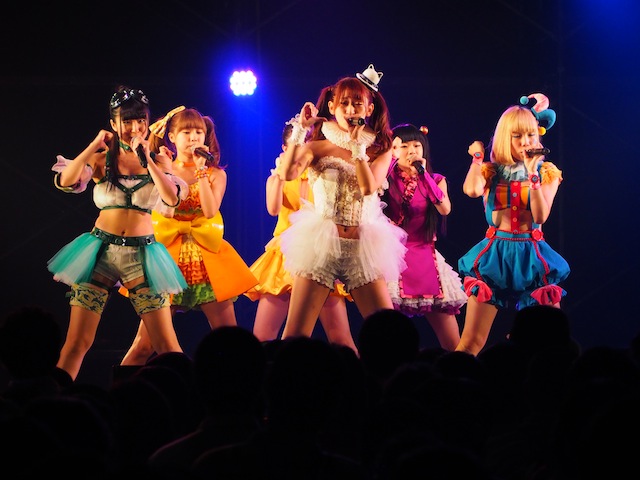
Also, despite the festival atmosphere, it felt a lot like we were simply being marketed to. Sponsors such as Live DAM Karaoke took long slots on the main stage, while many of the booths belonged to brands that use Kyary Pamyu Pamyu in their advertising. Live DAM Karaoke is one of those, actually, as well as a job-hunting company and this toothpaste brand.
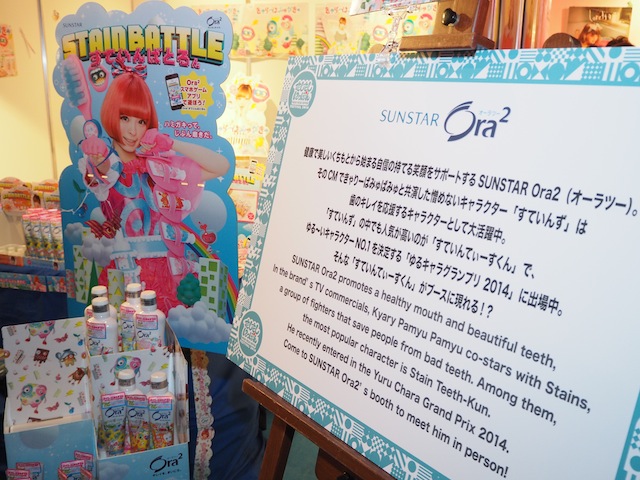
Still, Kyary’s set was pretty good. She only played three or four songs, including the obligatory “Fashion Monster,” which is a fierce slice of house production cut through with pure pop melody, and it sounded great on the bass-heavy PA. I saw Kyary at two other festivals this summer, but Moshi Moshi Nippon was more of a home crowd, and she seemed more at ease as a result.
So, what did the foreigners in the audience think? Opinions were mixed.

Max (from America, on the right here): “Can I be honest about what a train wreck I think this is? It’s a huge fucking train wreck. All the foreigners here already live in Japan, and yet everybody’s being treated like a tourist on their first day in Japan. The music here is no worse than American pop, but it’s the wrong kind of music for a foreign audience. There are a lot of really cool bands in Japan playing interesting, cutting-edge music, and you already get a mix of Japanese and foreigners at their shows. Today it’s pretty much all idol groups with no variety.”

Anthony (France, center): “I came here for Kyary Pamyu Pamyu. I’ve only lived in Japan for five months so this is my first time to see her. The rest of the music is kinda different… Good different, I guess. We got free entry, which is kind of weird, because the Japanese had to pay. Why? I feel guilty about it. I don’t want to go in a special foreigners’ viewing area, either.”

Ashiya (Russia): “I came because it was free, and I thought it looked interesting. I like Kyary Pamyu Pamyu, but all the other artists I saw for the first time. It’s been fun. I didn’t go into the foreigners’ area though. I think it’s not necessary, because it’s like discrimination. I think it’s nicer if the Japanese and foreigners can all be together.”

Simon (England): “I guess they’re trying to promote Japanese culture around the world, but it’s a bit weird to hold the event in Japan, because everyone here is already in Japan and they already know about Japanese culture.”
Undrakh (Mongolia): “I was happy to get free entry and a private section for foreigners, because it’s the only time we get special treatment in Japan. It was like being in a foreign country.”
As for me, I think that some of what the organizers did was helpful in fostering interest in a foreign audience, even if those foreigners are already based in Japan. Everything from the artists’ names on the lineup to the venue information was available in English, which makes it more approachable for foreigners who don’t speak Japanese, and of course free entry was critical in convincing people with only a passing interest in J-pop to go along.
The segregated viewing area was a terrible idea, though, and felt quite sinister. The idea that you would invite 3,000 foreigners and not have a bar selling alcohol anywhere in the building is insane—the organizers could have made more than the ticket price from drink sales alone, and the atmosphere would have been less stilted for sure. And eight hours of idol pop is enough to test anyone’s nerves.
But as a carnival of spectacle it was a success. Hopefully Asobi System will ditch some of its weirder policies if it Moshi Moshi Nippon happens again next year.
Oh, and not to boast, but I finally got to meet Kyary Pamyu Pamyu in the flesh. Well, sort of.

Follow Daniel on Twitter


